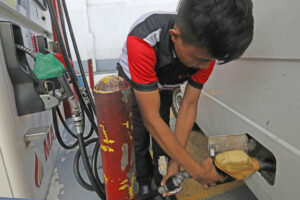After three years of war in Ukraine, Europe’s security guarantees face the abyss
DoE eyes implementation of higher biodiesel blend in July


By Sheldeen Joy Talavera, Reporter
THE DEPARTMENT of Energy (DoE) is proposing to implement the long-delayed increase in the coco biodiesel blend to 3% starting July 1.
In a draft department circular, the DoE proposed that all diesel fuel sold in the country contain a biodiesel blend at 3% effective July 1, from 2%.
It also proposed to hike the biodiesel blend to 4%, effective July 1, 2025, and to 5% on July 1, 2026.
The Biofuels Act of 2006 mandates that all liquid fuels for motors and engines contain locally sourced biofuel components.
Oil companies must use a 2% biodiesel blend by volume in all diesel fuel sold and distributed in the country since February 2009.
“The downstream oil sector may offer consumers a gasoline fuel containing 20% bioethanol blend on a voluntary basis,” the DoE said in the circular.
Since February 2012, oil retailers have been required to implement a 10% bioethanol blend in gasoline fuel sold locally.
In November, the Cabinet-level National Biofuels Board recommended the higher biodiesel blend starting this year, as well as the voluntary implementation of the higher bioethanol blend.
Once approved, the DoE said the circular would be applied to all participants in the downstream oil and the local biofuel producer industries.
With the proposed policy, the DoE said the downstream oil industry should prepare “to ensure the managerial and operational requirements for the transition to the higher biofuel blend.”
Companies should ensure enough storage capacity for increased biofuel supply, as well as sufficient blending facilities and a compatible transport system.
Fuel retailers that will implement the 20% bioethanol blend are expected to have a dedicated storage tank and dispensing pump. Pump attendants should ensure that vehicles can handle the 20% bioethanol blend.
Biofuel producers are also encouraged to prepare for the expected increase in demand, such as ensuring access to sufficient feedstock.
In October, Energy Secretary Raphael P.M. Lotilla said increasing the ethanol blend could cut gasoline prices by as much as P1 a liter.
“This is primarily a price mitigation measure because ethanol, especially imported ethanol, is cheaper than the price of gasoline,” Mr. Lotilla said.
Terry L. Ridon, a public investment analyst, said raising the biodiesel blend would “broaden the utilization of coconut oil for biodiesel in the medium term.”
“However, both the government and the coconut industry will have to decide the best utilization of the nation’s coconut oil supply, as foreign buyers, such as the international cosmetics industry, will also compete for the same supply but may offer premium pricing,” he said in a Viber message.
Bienvenido S. Oplas, Jr., president of Minimal Government Thinkers, said higher biodiesel blend could drive food prices up.
“Corn and other crops should feed people and animals, not cars. It will have an adverse impact on food prices and could worsen instead of mitigate high food inflation,” he said in a Viber message.
Both analysts said the higher biodiesel blend might not necessarily lead to lower local oil prices because these still depend on the global market.
“World oil prices fluctuate up and down, but biodiesel mandates are permanent, with permanent price distortions,” Mr. Oplas said.
Mr. Ridon said the government should ensure that the higher blend is supported by domestic agricultural production. “It makes no sense to the local economy to undertake a higher mandatory percentage of bioethanol if the supply will be provided by imports.”











